A) zero newtons
B) 10 N
C) 20 N
D) 25 N
E) 30 N
Correct Answer

verified
Correct Answer
verified
Multiple Choice
A block of mass M is held motionless on a frictionless inclined plane by means of a string attached to a vertical wall as shown in the drawing. 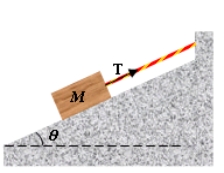 -Assume the plane is not frictionless and the string breaks, what minimum value of the coefficient of static friction, s, would prevent the block from sliding down the inclined plane?
-Assume the plane is not frictionless and the string breaks, what minimum value of the coefficient of static friction, s, would prevent the block from sliding down the inclined plane?
A) zero
B) 1
C) cos
D) sin
E) tan
Correct Answer

verified
Correct Answer
verified
Multiple Choice
A 2150-kg truck is traveling along a straight, level road at a constant speed of 55.0 km/h when the driver removes his foot from the accelerator.After 21.0 s, the truck's speed is 33.0 km/h.What is the magnitude of the average net force acting on the truck during the 21.0 s interval?
A) 2250 N
B) 626 N
C) 1890 N
D) 972 N
E) 229 N
Correct Answer

verified
Correct Answer
verified
Multiple Choice
A horse pulls a cart along a flat road.Consider the following four forces that arise in this situation. (1) the force of the horse pulling on the cart (3) the force of the horse pushing on the road (2) the force of the cart pulling on the horse (4) the force of the road pushing on the horse -Which two forces form an "action-reaction" pair that obeys Newton's third law?
A) 1 and 4
B) 1 and 3
C) 2 and 4
D) 3 and 4
E) 2 and 3
Correct Answer

verified
Correct Answer
verified
Multiple Choice
A block of mass M is held motionless on a frictionless inclined plane by means of a string attached to a vertical wall as shown in the drawing.  -If the string breaks, what is the magnitude of the acceleration of the block as it slides down the inclined plane?
-If the string breaks, what is the magnitude of the acceleration of the block as it slides down the inclined plane?
A) zero m/s2
B) g
C) g cos
D) g sin
E) g tan
Correct Answer

verified
Correct Answer
verified
Multiple Choice
A block is at rest on a rough inclined plane and is connected to an object with the same mass as shown.The rope may be considered massless; and the pulley may be considered frictionless.The coefficient of static friction between the block and the plane is µs; and the coefficient of kinetic friction is k. 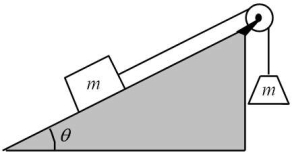 -What is the magnitude of the static frictional force acting on the block?
-What is the magnitude of the static frictional force acting on the block?
A) mg sin
B) mg cos
C) mg(1 - sin )
D) mg(1 - cos )
E) mg
Correct Answer

verified
Correct Answer
verified
Multiple Choice
A system of two cables supports a 150-N ball as shown. 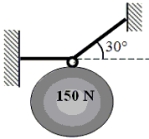 -What is the tension in the horizontal cable?
-What is the tension in the horizontal cable?
A) 87 N
B) 150 N
C) 170 N
D) 260 N
E) 300 N
Correct Answer

verified
Correct Answer
verified
Multiple Choice
At a playground, a child slides down a slide that makes a 42° angle with the horizontal direction.The coefficient of kinetic friction for the child sliding on the slide is 0.20.What is the magnitude of her acceleration during her sliding?
A) 4.6 m/s2
B) 5.1 m/s2
C) 5.4 m/s2
D) 6.3 m/s2
E) 9.8 m/s2
Correct Answer

verified
Correct Answer
verified
Multiple Choice
A net force  is required to give an object with mass m an acceleration a.If a net force 6
is required to give an object with mass m an acceleration a.If a net force 6  is applied to an object with mass 2m, what is the acceleration on this object?
is applied to an object with mass 2m, what is the acceleration on this object?
A) ![]()
B) 2 ![]()
C) 3 ![]()
D) 4 ![]()
E) 6 ![]()
Correct Answer

verified
Correct Answer
verified
Multiple Choice
A 2.00-kg projectile is fired at an angle of 20.0°.What is the magnitude of the force exerted on the projectile when it is at the highest position in its trajectory? Neglect any effects of air resistance.
A) 19.6 N
B) 14.7 N
C) 9.80 N
D) 4.90 N
E) 0 N
Correct Answer

verified
Correct Answer
verified
Multiple Choice
A rock is suspended from a string; and it accelerates downward.Which one of the following statements concerning the tension in the string is true?
A) The tension points downward.
B) The tension is less than the weight of the rock.
C) The tension is equal to the weight of the rock.
D) The tension is greater than the weight of the rock.
E) The tension is independent of the magnitude of the rock's acceleration.
Correct Answer

verified
Correct Answer
verified
Multiple Choice
A physics student in a hot air balloon ascends vertically at constant speed.Consider the following four forces present in this situation:  1 = the weight of the hot air balloon
1 = the weight of the hot air balloon  3 = the force of the student pulling on the earth
3 = the force of the student pulling on the earth  2 = the weight of the student
2 = the weight of the student  4 = the force of the hot air balloon pulling on the student
-Which two forces form an "action-reaction" pair that obeys Newton's third law?
4 = the force of the hot air balloon pulling on the student
-Which two forces form an "action-reaction" pair that obeys Newton's third law?
A) ![]() 1 and
1 and ![]() 2
2
B) ![]() 2 and
2 and ![]() 3
3
C) ![]() 1 and
1 and ![]() 3
3
D) ![]() 2 and
2 and ![]() 4
4
E) ![]() 3 and
3 and ![]() 4
4
Correct Answer

verified
Correct Answer
verified
Multiple Choice
Which one of the following statements concerning the two "gravitational constants" G, the universal gravitational constant, and g the magnitude of the acceleration due to gravity is true?
A) The values of g and G depend on location.
B) The values of g and G do not depend on location.
C) The value of G is the same everywhere in the universe, but the value of g is not.
D) The value of g is the same everywhere in the universe, but the value of G is not.
E) The values of g and G are equal on the surface of any planet, but in general, G varies with location in the universe.
Correct Answer

verified
Correct Answer
verified
Multiple Choice
Three spring scales are attached along a straight line as shown.The scale on the left is attached to a wall.A force of 15 N is applied to the scale at the right.  What is the reading on the middle scale?
What is the reading on the middle scale?
A) 0 N
B) 45 N
C) 10 N
D) 5 N
E) 15 N
Correct Answer

verified
Correct Answer
verified
Multiple Choice
4-6
A force  pulls on a crate of mass m that is in contact with a rough surface.The figure shows the magnitudes and directions of the forces that act on the crate in this situation.
pulls on a crate of mass m that is in contact with a rough surface.The figure shows the magnitudes and directions of the forces that act on the crate in this situation.  represents the weight of the crate.
represents the weight of the crate.  represents the normal force on the crate, and
represents the normal force on the crate, and  represents the frictional force.
represents the frictional force. 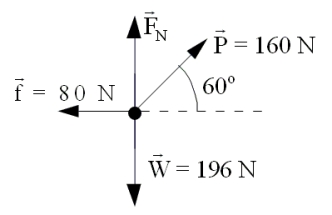 -Which statement best describes the motion of the crate?
-Which statement best describes the motion of the crate?
A) The crate must be at rest.
B) The crate must be moving with constant velocity.
C) The crate must be moving with constant acceleration.
D) The crate may be either at rest or moving with constant velocity.
E) The crate may be either at rest or moving with constant acceleration.
Correct Answer

verified
Correct Answer
verified
Multiple Choice
A crate rests on the flatbed of a truck that is initially traveling at 15 m/s on a level road.The driver applies the brakes and the truck is brought to a halt in a distance of 38 m.If the deceleration of the truck is constant, what is the minimum coefficient of friction between the crate and the truck that is required to keep the crate from sliding?
A) 0.20
B) 0.30
C) 0.39
D) 0.59
E) This cannot be determined without knowing the mass of the crate.
Correct Answer

verified
Correct Answer
verified
Multiple Choice
An object moves due east at constant speed.A net force directed due north then acts on the object for 5.0 s.At the end of the 5.0-second period, the net force drops to zero newtons.Which one of the following statements is necessarily true?
A) The object will be moving eastward when the force drops to zero newtons.
B) The change in the velocity of the object is directed north of west.
C) The direction of the object's acceleration depends on how fast the object was initially moving.
D) The final velocity of the object is directed north of east.
E) The magnitude of the object's acceleration depends on how fast the object was initially moving.
Correct Answer

verified
Correct Answer
verified
Multiple Choice
Two blocks rest on a horizontal frictionless surface as shown.The surface between the top and bottom blocks is roughened so that there is no slipping between the two blocks.A 30-N force is applied to the bottom block as suggested in the figure. 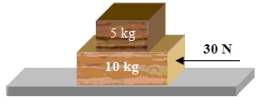 -What is the minimum coefficient of static friction necessary to keep the top block from slipping on the bottom block?
-What is the minimum coefficient of static friction necessary to keep the top block from slipping on the bottom block?
A) 0.05
B) 0.10
C) 0.20
D) 0.30
E) 0.40
Correct Answer

verified
Correct Answer
verified
Multiple Choice
A 10-kg block is connected to a 40-kg block as shown in the figure.The surface on that the blocks slide is frictionless.A force of 50 N pulls the blocks to the right.  -What is the magnitude of the acceleration of the 40-kg block?
-What is the magnitude of the acceleration of the 40-kg block?
A) 0.5 m/s2
B) 1 m/s2
C) 2 m/s2
D) 4 m/s2
E) 5 m/s2
Correct Answer

verified
Correct Answer
verified
Multiple Choice
The figure shows the velocity versus time curve for a car traveling along a straight line. Which of the following statements is false? 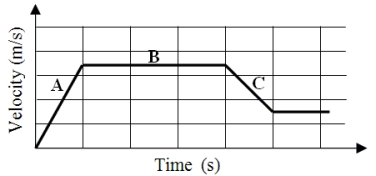
A) No net force acts on the car during interval B.
B) Net forces act on the car during intervals A and C.
C) Opposing forces may be acting on the car during interval B.
D) Opposing forces may be acting on the car during interval C.
E) The magnitude of the net force acting during interval A is less than that during C.
Correct Answer

verified
Correct Answer
verified
Showing 21 - 40 of 103
Related Exams